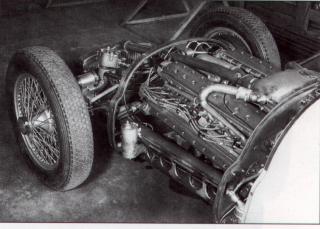her er forresten lidt info om brm'eren
The complex, supercharged V16 was at least orthodox in its layout and the 1947 design target power output of 300 bhp appeared adequate. However, it was not generous, for the simple straight-eight in the Alfa Romeo 158, the car to beat, was rated at 254bhp in 1946 and 300bhp in the 1947 model. There was, however, more development potential in the V16, and it was envisaged that it would be a competitive power unit through to 1953. In the early days it was estimated that by 1953,
600 bhp at 12,000 rpm would be achieved.


The short-stroke, high-revving Vl6 had its cylinder banks at an included angle of 35 degrees, with alloy cylinder heads and block, and tiny cast-iron liners (a weak point, as they broke up when coolant leaked into the cylinders). The engine could be regarded as a pair of 744cc V8s with a common two-piece, 10-bearing crankshaft. There was a half speed power take-off at its centre, with trains of gears operating the twin overhead camshafts. The drive for the supercharger was taken from the front of the output shaft, forward via a gear train.




